12 Painting Mistakes Made by RV Owners (and How to Avoid Them)
This post may contain affiliate links.
Painting your RV walls and cabinets is an inexpensive way to transform your living space completely. But a few painting mistakes can quickly turn your shiny new space into a maintenance nightmare.
In this article, I share 12 common painting mistakes so you can paint your RV perfectly for the first time.
Related: A Complete Guide to Painting Your RV Walls
1. Inadequate surface prep
Surface prep is a time-consuming necessity—as much as you may want to skip it! Even though some products and paints promise you can skip it altogether, the best way to guarantee a great paint job is to prep your surface adequately. A little elbow grease now will save you from re-painting again in the future, costing you time and money!
One RV owner learned this lesson the hard way when she painted her laminate cabinets without priming. It wasn’t too much later that the paint started peeling off!

To avoid peeling, you must ensure the surface you’re painting has a texture the paint can “grab on” to. To oversimplify it, this is the purpose of primer. It is what your paint will grab onto.
The best method for creating a surface that paint will adhere to depends on what type of material you’re painting. This brings me to the next common painting mistake.
2. Using paint or primer that’s wrong for the surface
When I was young, I accidentally used interior latex paint on some exterior trim on our house. My dad told me it would need to be sanded and repainted, but I couldn’t see the problem. Sure enough, a few months later, the paint started cracking and flaking off. That experience taught me how important it is to use the right kind of paint for whatever project you’re doing.
Read Next: The Best Paint Brands for Painting RV Walls and Cabinets
Kilz is renowned in the RV world for having the best primer. You can use it on both your walls and your cabinets. For your RV interior, you will want an interior latex-based paint. There are multiple brands that RVers recommend that world well; just be sure to prime and paint separately.
3. Not reading the instructions for the products being used
One RV owner read that she wouldn’t have to sand her cabinets as long as she used a certain kind of paint. Skipping sanding is pretty appealing.
Unfortunately, the paint ended up peeling off her laminate (fake) wood cabinets. She ended up having to strip and sand it all off. More time, more elbow grease, and even more money!

Later, she discovered that the paint company’s website said to sand first! Lesson learned. While blogs and Facebook can be great resources for gathering information, they are no replacement for reading and following the product’s instructions! What worked for someone else, might not work on your RV. Always read the product instructions before you purchase.
4. Using cheap paint brushes
You can get a value pack of several paintbrushes for about the same price as one quality paintbrush. However, using a cheaper brush can result in brush strokes showing or bristles falling out and sticking to the paint. I like Purdy brand paintbrushes, but I know many people like Wooster brand as well.
- PURDY XL PAINT BRUSHES - Purdy XL Series brushes are great for all types of environments, both interior and exterior. These paint applicators will help you get the job done right the first time.
5. Planning to fix mistakes later
Some paint was on this trim piece when we were painting our RV walls. Oops, but no big deal. It was easy to scrape off, so we figured we would worry about it later.
A few months later (ha!) I finally got around to it, only to discover the paint wasn’t quite so easy to scratch off! It cured and is harder to remove. I still haven’t gotten around to it yet!

6. Not waiting long enough for the paint to cure
Paint scratches off easily the first few days after painting and becomes more durable after it cures for several days or weeks. Avoid doing anything that might scratch the paint, like moving in furniture, until the paint has cured.

If your paint does scratch within the first week or so, don’t despair! Give it at least a week before determining whether there is a problem with paint adhesion or if the paint was just scratched before curing.
7. Painting when it’s too cold, too hot, or too humid
Temperature and moisture affect primer and paint. After leaving on a space heater while the paint was drying, this RV came back to see this:

The paint had developed a splotchy appearance while drying. Another RV owner reported a similar experience when condensation built up on her RV walls while she painted with the heater running. Most paints recommend that you don’t apply in temperatures under 50º as it affects the paint. You may think that running a heater in winter would be fine, but the direct heat and condensation heaters cause can hurt the paint.
Fortunately, the residue in this photo disappeared after the RV owner wiped down the walls with a damp rag. Avoid problems by reading your paint can and finding the optimal temperature range and humidity level. You may need to run a dehumidifier while painting in some climates.
8. Using homemade chalk paint
Chalk paint is common in RVs. One RV owner I know decided to save money by making her own chalk paint using a recipe found online. She used homemade chalk paint successfully before when painting furniture, but it peeled off when she used it to paint her RV cabinets. She didn’t know exactly what caused the problem and had to sand it all off.
I’m not saying homemade chalk paint will never work. You might get lucky, and maybe you’re on a tight enough budget that the risk is worth it.
Using a highly recommended name brand can remove some of the risks and increase your chances of ending up with a result you love. Plus, you may get a refund if your name-brand paint has problems. I actually got a refund once on some spray paint that came out drippy and uneven.
9. Painting over seams that may shift during travel
I don’t consider this a painting mistake since I’m not sure it could have been anticipated, but it was a problem faced by RV owner Christina.
When painting her RV, she covered the seams between the cabinets and the wood trim. The first time Christina’s RV was moved after the cabinets were painted, the paint bubbled up as the RV shifted during transit.

To prevent this problem, score seams with a razor blade after the paint has dried and before the RV is moved.
10. Not testing colors first
I wanted light gray when I chose the paint color for my walls, but it looked white in the sunlight! I have a friend who bought paint named charcoal, but one coat revealed that it was blue, not grey!
Avoid this by purchasing a sample size of the paint first. Any paint store will do this for a couple of dollars. Paint a test area or paint a poster board and hold it under different lighting in your RV.
11. Waiting too long to remove painter’s tape.
If you remove the painter’s tape while the paint is still wet, you might accidentally smudge the paint. If you wait until it’s completely dry, the tape might peel the paint off! That’s what happened in the RV pictured below.

Remove tape while the paint is still tacky, but not completely liquid. The tape can easily break through the paint but won’t cause it to smear. If you notice that the paint is coming up with the tape, use a razor blade to score along the edge before you pull.
12. Trying to do it all in one coat
When you’ve bought a type of paint that was advertised as requiring only one coat, it can be frustrating to see the old wall color showing through. But that doesn’t mean you should just roll the paint on thicker.
A thick layer of paint or going back over painted areas before they are fully dry, can interfere with drying time. This can result in an uneven finish or leave visible brush strokes or marks from the paint roller.
Plan on two coats for anything you paint in your RV. (Even your RV shower!) Then, if you find you only need one, you will be pleasantly surprised!
Avoid These 12 RV Painting Mistakes
Anyone can paint, but it is easy to make painting mistakes, even if you’re a seasoned DIYer! Keep these 12 mistakes in mind as you prep, paint, and enjoy your beautiful RV.
Feeling bold? Paint your RV exterior!
Ashley Mann spent three years living full time in a 38-foot, 5th-wheel RV with her husband Josiah and their cat, Kitty. Her favorite thing about RV life is the challenge of finding the perfect way to organize a space, and she loves seeing all the creative and clever ways people come up with to customize their RVs.




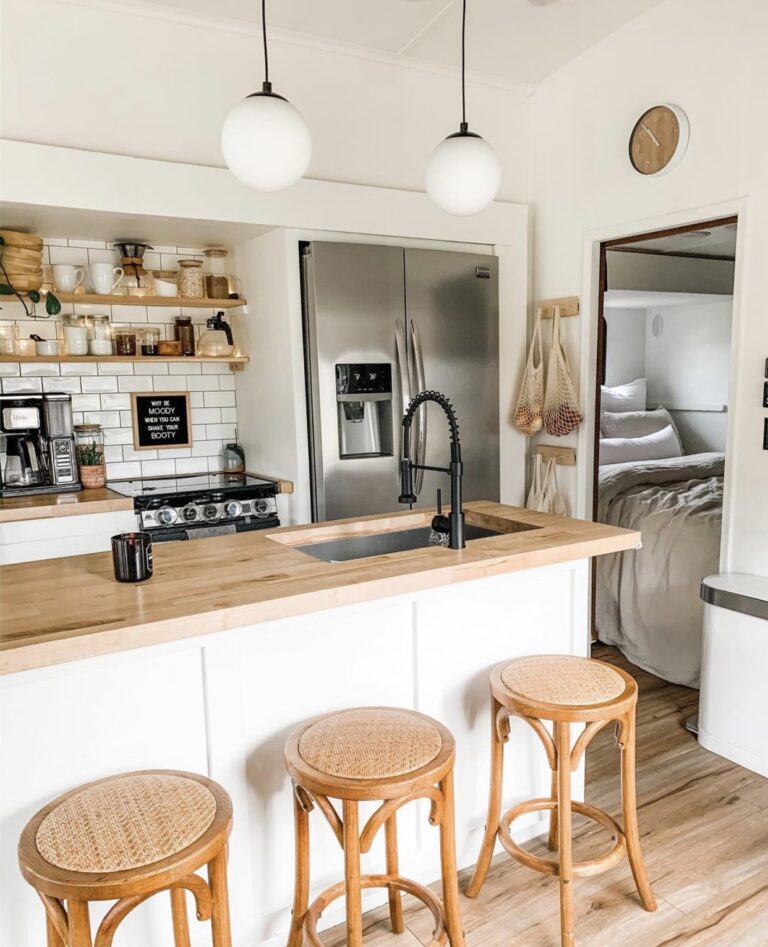

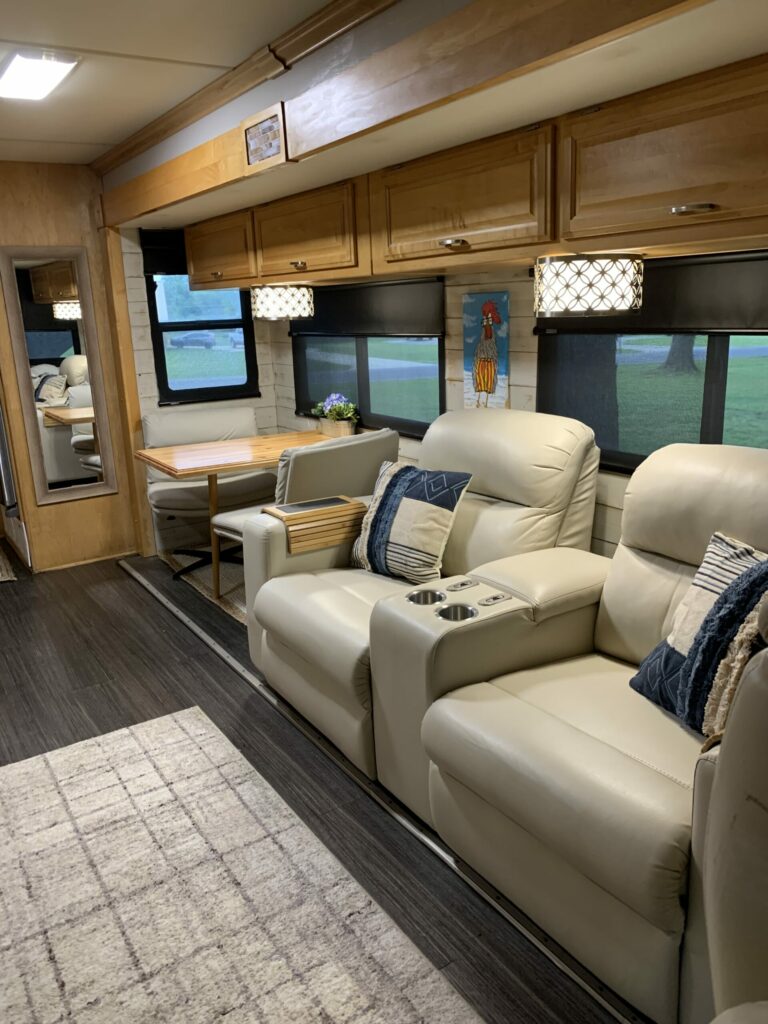
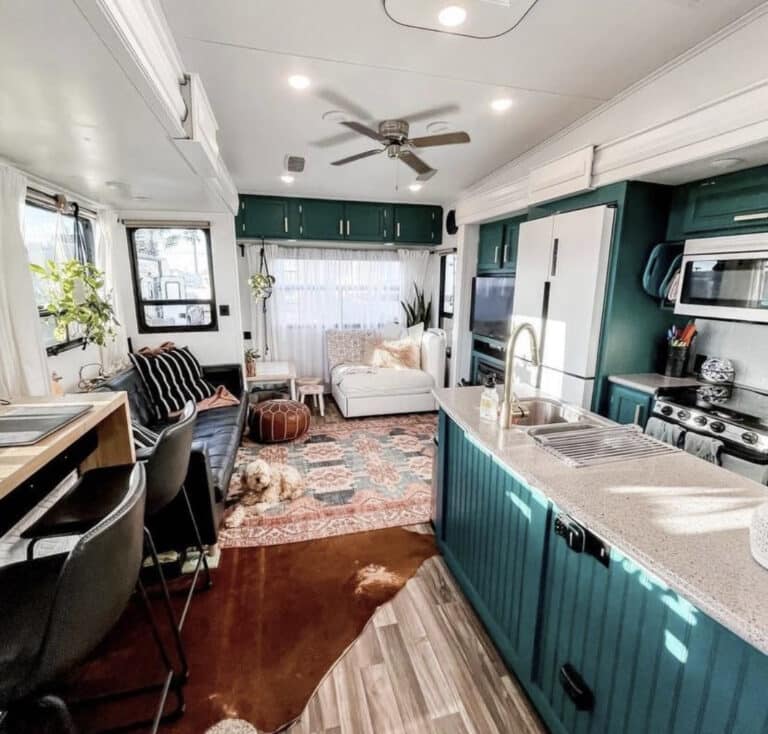
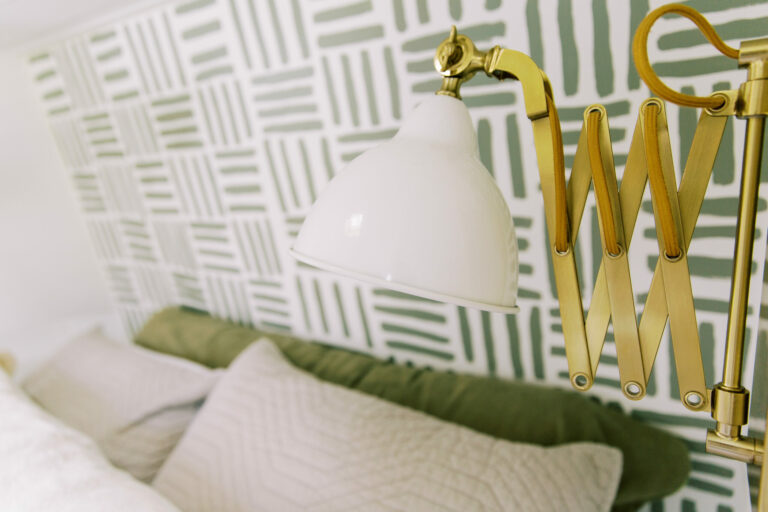
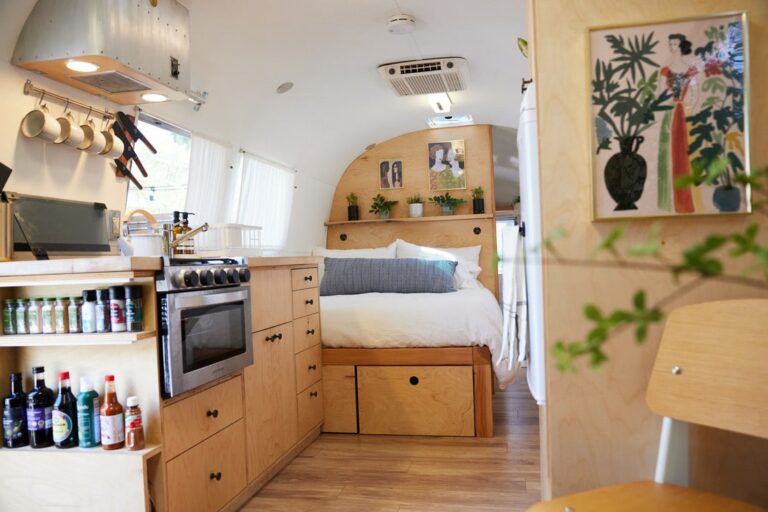
I have a 2001 pop up camper. So cute. Brings back childhood memories with my grandma and siblings. Good times. I want to share these experiences with my husband.
I want to give it some piazza. I’m a carpenter and woodworker. I know to to clean surfaces with TSP and sand everything before painting. But something you haven’t mentioned is spraying cabinets. My thought was to remove them to paint them. Then cover with polyurethane afterwords. I anticipate it taking at least a week to allow for proper drying. I’ve used this process on furniture with success. But…your mention of humidity, condensation from temperature changes and camper movement made me think about any consideration I need to know. Thoughts???
I haven’t had as much experience with spraying as I have with brush and roller, but I would imagine just like with other methods it would work as long as the surface was properly prepared and instructions on the label were followed as far as temperature, drying time, etc. Here’s an article that might be helpful and inspiring to you – it shows pictures of a whole bunch of pop-up camper makeovers, and if you click the link below each you can read about them in more detail, which may include information about the techniques they used for painting. Good luck! Sounds like a fun project!
Great list of do and don’t items. As a retired painting contractor I would add 2 items: 1. Don’t bite off more than you can chew! Take your time and be thorough with each phase. 2. For problem stains and priming over wallpaper, laminate, etc. try shellac primer (Bullseye by Zinsser) or good oil based primer. water based primers can moisten and sometimes lift off a porous substrate.
Thank you for your additional tips! And for letting me know that as a paint professional you like my list! 🙂
I just bought a 1969 Giles camper. It’s in surprisingly great shape but it’s been stationary lake side for years and won’t be moved because of the trees grown up around it. So, I am remodeling. The first thing I did of course was to paint, being it was all paneling and dark wood. I primered with kilz first and still had to roll on three coats of white but I’m still worried about peeling especially in the bathroom. So, now I’ve decided to wallpaper the bathroom instead. Any advice on what brand of wallpaper would be best against molding or peeling?
Sorry, I don’t have personal experience with using wallpaper in a camper. If you’re on Facebook, I would suggest asking the members of the group “RV Interior Ideas” what types of wallpaper have worked best for them. Have you had a problem with the paint peeling already? If not, you could also try it just to see if it works…since you used a good primer, as long as you follow the instructions as far as what type of paint over to use over that type of primer, I would think it should work, if you still preferred to go that route.
I recently purchased a camper. The previous owners had painted cabinets and choice walls. My best guess is they used latex paint. As far as I can tell no primer was used. Yet paint has held up well. I would like to paint over the previous paint. My question is should I use oil primers and paint or should I use latex base paints? She really needs TLC.
Thanks for any help
Hi Pauline, in researching the question of latex vs. oil based paint, I have seen people say you should never use oil based paint over latex based paint, and others who say it’s the other way around, that you should never used latex paint over oil paint. I think to be safe I would try to stick with the same type of paint that was used previously.
For your cabinets, I would recommend using a citrus gel paint stripper and then thoroughly sanding them (if they are real wood) before using a primer, then a paint. If they are laminate the same process should work minus the sanding so as not to damage the laminate surface; instead you might use a plastic scraper to remove the old paint after applying the stripper, and you will probably want to use a bonding primer such as Glidden Gripper.
For the walls, I would do a bit of research to find best methods for painting over latex paint, but typically I would say sand to rough up the existing paint (but not to remove it), and then paint with a latex paint + primer. You shouldn’t need a second coat of primer as long as the bottom layer of paint is holding up well and as long as you are using the same type of paint that was used the first time.
That’s my advice! I would also suggest asking a paint professional at a paint store for a second opinion!
I’m a maintenance tech for over 30 years, I’ve done a lot of painting, you can paint oil over latex but not latex over oil if you do just rubbing against it with clothing will take it of, oil needs sanded or a good bonding primer paint before painting with latex
Thanks for this tip!
We used appliance spray paint on the laminate trim & all the cabinets. It worked fabulously!
I have heard of others having success with spray paint on their cabinets! Did you go through a lot of cans?
I’m thinking about painting the cabinets in my camper, but it just looks like a 1/4 inch board with a paper like sticker with a wood grain printed on it. My concern is how do I strip it and get it ready for primer? And also when I apply primer I’m afraid that the moisture from the paint will lift off the sticker, Any suggestions???
What you are describing sounds like a type of laminate wood. If you Google “how to paint laminate wood cabinets” you can probably find some info about it; I’ve also linked to blog posts written by RV owners who successfully painted this type of material my Ultimate Guide to Painting Your RV Interior.
Since the purpose of stripping is to remove old paint and varnish from wood, you don’t need to strip it, and you also don’t want to sand it because you might tear through the wood grain sticker. I suggest thoroughly cleaning it, then lightly sanding it with a fine grit paper to roughen the surface just a bit. Then I would use either a cabinet paint specially designed for this type of application, or a bonding primer such as Glidden Gripper followed by latex paint. Alternatively, I have seen some RV owners who used spray paint on that type of material instead of regular primer and paint, but if you have a lot of cabinets to paint that could get expensive.
I have a ’93 class A that is in good shape. But is in need of a facelift. It has the paper laminate cabinet faces everyone is
concerned about, including.
After reading through much of this blog, best I’ve come across BTW. I’ve come to a conclusion.
>Technique- Peel off any laminate that will come off easily. Scrub with TSP and a red scotch bright pad. This will be a sand and clean in one step. Allow to dry thoroughly.
>Materials- Use and oil based primer (Zinsser). Finish with cabinet specific paint.
Will this work?
Glad you found this article helpful! My concern with peeling off the laminate would just be with what type of wood is underneath. If the wood under the laminate has a smooth texture and you are able to remove any adhesive (I would use GooGone for this instead of TSP as TSP is more for cutting through grease) then I think the process you describe would work. However, if the wood behind the laminate is particle board, it might have a rough/furry texture when you peel off the laminate that will only get rougher with sanding, especially if water is applied because the particle board will absorb the liquid. (I know this because I recently experienced it when I removed the wallpaper from a dollhouse I’m “renovating” and now have rough walls I have to figure out how to recover somehow!) I would only remove the laminate if it is already peeling, and in that case I would just remove the loose parts and then apply spackling to smooth over the gaps before painting. A good bonding primer is designed to adhere to any surface and should work on top of laminate (and would save you a lot of work). Beyond brand cabinet paint also reportedly works over laminate RV cabinets. Good luck with your project!